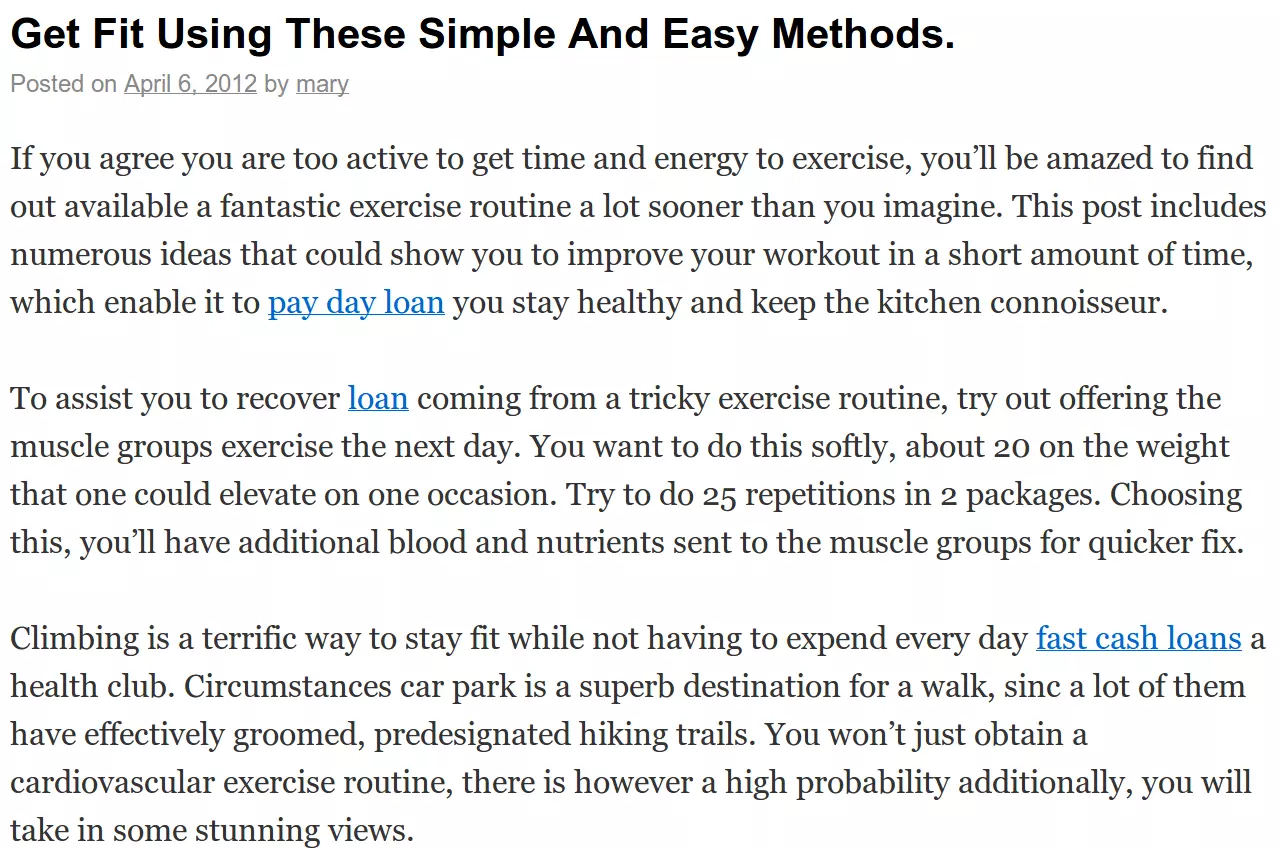
1 min
OpenGoogle SpamBrain
7 mins
Anchor text is the descriptive text of an outbound link. It is clickable, and it’s readable to both the user and to search engines.
31 January 2023

Every link coming into a website is seen by search engines as a mark of endorsement from the linking website. As far as the search engine is concerned, the more endorsements, the more relevant and trusted your website must be, and thus the higher it would rank in results. How this link is described in the anchor text is considered to be one of the top three ranking factors, and remains an integral part of any content marketing or SEO campaign.
In short, anchor text is a hyperlink to a given information source. In a browser it is usually underlined:
Anchor text does not have to show the URL that it is linking to. It can simply describe the destination:
In the code, it looks like this:
<a href=”http://www.yourwebsite.com”>Chosen Anchor Text</a>
To optimise an inbound link to positively influence your webpage SEO, there are a number of things to consider when it comes to your choice of of anchor text.
Search engines use anchor text as one way to understand what the linked-to page is about. It is a major ranking factor as the engines consider anchor text to be generally unbiased, user generated information. Because one page can have many different links to it, with many variations of anchor text, the search engines are provided with many differing opinions on the contents of the page.
It goes both ways: There are the SEO benefits of the anchor text to the destination page it is linking to, and the benefit to the page the link is on.
But be warned, aggressive anchor text that lacks diversity and relevancy can result in ranking penalties for the linked-to site. Here’s Google’s example of content it considers spam:

Notice that the outgoing links are completely unrelated to the actual content, and target the same keywords on repeat. It starts to appear suspicious, and is often a sign that the links weren’t acquired naturally. In this case, the linked-to site was penalised for spam.
The anchor text is also what entices a user to click on the link, but do not waste anchor text opportunity by using terms such as ‘click here’ or ‘more information’—this tells the search engines nothing about the page. Good anchor text will use your targeted keywords to indicate the key topics of the linked page you are talking about, rather than generic text.
Everything begins with good keyword research. You want to know what terms you are targeting, the relative competition around those keywords, and the popularity of those terms. Ultimately, you want your site’s inbound links to contain anchor text that search engines will associate with your content. Read more in our guide to keyword research.
Best SEO practice for anchor text for a link to the Disneyland homepage, for example, might look a little like this:
… if you’re looking for a holiday destination that’s fun for all the family, check out the family resort in Paris.
Whenever the terms ‘family resort’ and ‘Paris’ are Googled, the linked-to page (www.disneylandparis.com) is more likely to rank somewhere in the results, because the inbound link indicates it is an authority.
However, when content writers employ keyword stuffing (overloading your content with keywords) to aggressively build branded keyword or exact match links, search engines consider the user experience to be compromised and can penalise your website. If anchor text is to be relevant to the page you’re linking to, individual keywords are no longer enough to form the foundation of your anchor text—it must be relevant.
Anchor text that mentions your brand name is an important metric for search engines. A good volume of brand name mentions in your incoming links is extremely important for rankings. If you’re an authority on a subject, it’s fairly safe to use branded anchor text to link directly to the homepage, for example:
If you’re looking for the perfect family holiday, Disneyland Paris could be the perfect destination for you.
Google’s push on brand goes much further than simply taking into account brand mentions in anchor text. It is now placing a lot of emphasis on overall brand mentions across the Internet. This is where effective Social Media Marketing can really help, boosting your presence across multiple platforms.
Still, it’s important not to over-optimise for branded links, as Google has begun to place a huge amount of effort into finding and penalising sites for overly optimised links. If you have too many incoming links with perfect anchor text, this is usually a pretty good indication of manipulative behaviour. The solution? Organic-looking links.
An organic link usually refers to a link made to your site by an independent party. They are not elicited in any way, and tend to be considered more ‘natural’ as they do not necessarily use the branded name. As content strategists, we can mimic this ‘organic’ link in order to link to a key service, knowledge or original information, and avoid penalties for overly-optimised links.
Let’s assume we’re still writing an article on theme parks, but this time, for www.parisbytrain.com:
… if you’re wondering how to get to this world-renowned family theme park, it takes just a few minutes by train from Paris to Disneyland.
Google is less likely to trust a train company to be an authority on theme parks, so a branded link is likely to be penalised as spam. Yet, as said train company operates a direct service to the park, a link to that page would be considered a relevant link to make. In these cases, the anchor text should be more descriptive of the page focus. Here, the anchor text targets a key search query “train from Paris to Disneyland.” Now search engines can associate that given train service with the Disneyland theme park and your site will benefit from the endorsement.
Bridging the gap between branded links and organic-looking links are page title, or blog post title links. These are thought to boost SEO in such cases as the linked-to page already ranks well for the keywords you are targeting, and especially when the linked-to page is a blog post or article that is siloed to the service page you are looking to boost.
The link appears organic, just the same way as it would to reference a news article by using its headline as your anchor text. If the page or blog post title you are linking to is well optimised, it will also likely contain the relevant key words you are targeting.
An example would be for us to link to a blog post on our site, Why You Need More Than Local Business Schema. The content of that post has high keyword relevance for ‘local search’ and ‘local seo’, and the URL for that page structurally trails back to our service page on Local Search.
Is the link on your page relevant to the content around it? Does it make contextual sense, or is it shoehorned in? Good content should use cooccurrence, or phrase-based indexing to strengthen topic focus and allow search engines to determine how semantically relevant your page link is. Linking for the sake of linking can raise a red flag.
And this is where secondary keyword research comes in: Optimising content to enable search engines to ’read’ what your content means. When popular terms and turns of phrase are built in, it constructs rich contextual signals that suggests your chosen link is appropriate to your content. It will therefore consider your link relevant and reliable, and reward your site in ranking.
If you’re a digital marketing agency, for example, and you’re being linked to from a marketing awards website, the ideal content surrounding your link would read something like this:
“The UK digital marketing industry is undergoing rapid transformation as it strives to adapt to the changing nature of the digital, AI and search engine landscape. Visionary SEO agencies such as Go Up are leading the way with this adaptation…”
Aside from our cringe worthy self-promotion and flagrant SEO efforts, this would be the ideal text surrounding the placement of any link to the Go Up website. The text surrounding the Go Up hyperlink speaks about SEO—a core service offering (along with PR, Link Building, Crisis Management, PPC, and content marketing… just so ya know…!) and only references our website as a means to exemplify their point.
In addition to anchor text and keywords, link metrics is a key marker of content quality. In much the same way as you would cite only verifiable sources in a news article or academic paper, online content should likewise only reference other content that is considered authoritative and reputable.
An ideal link would link from a relevant page on a relevant site to a relevant page on your site with relevant anchor text and surrounding content. This is because each link from a website is considered by the engines as an endorsement of the linked-to website.
Every web page will have its own Page Authority (a link based metric that isn’t directly used by Google, but variations of which are used by a number of well known SEO platforms such as aHrefs, Semrush and Moz and which does give a decent indication of how Google will perceive the link metrics of any given page). Internal links, therefore, can also be useful ranking tools. Not only do page to page links within a domain improve navigability and establish a hierarchy for your website, but they also help spread link juice (ranking power) around your site. On a page about anchor text that refers to internal links, for example, it might also be relevant to link to our link metrics guide, where you can find more information. As we’re aiding on-site navigation, the most appropriate anchor text is that which targets the page title.
For a link to be read, it must be crawlable by search engines and other content analysis procedures, which means structuring your content effectively.
Structure your content appropriately. Headers, paragraphs, lists, and tables all provide structure to content so that search engines understand your topic targeting. Inserting links with keyword anchor text in headings, subheads and at higher levels can improve visibility. If you’ve gone to the effort of optimising your anchor text, don’t hide it in footers and sidebars, and think about your term relationships to promote key phrases and links within bulleted lists.
There are a couple of other things to note too: